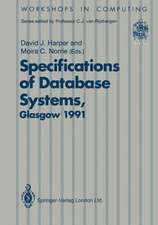Service Placement in Ad Hoc Networks: SpringerBriefs in Computer Science
Autor Georg Wittenburg, Jochen Schilleren Limba Engleză Paperback – 5 ian 2012
Din seria SpringerBriefs in Computer Science
-
 Preț: 475.83 lei
Preț: 475.83 lei - 20%
 Preț: 166.97 lei
Preț: 166.97 lei - 20%
 Preț: 325.63 lei
Preț: 325.63 lei - 20%
 Preț: 349.15 lei
Preț: 349.15 lei - 20%
 Preț: 302.49 lei
Preț: 302.49 lei -
 Preț: 381.81 lei
Preț: 381.81 lei -
 Preț: 446.47 lei
Preț: 446.47 lei - 20%
 Preț: 296.17 lei
Preț: 296.17 lei - 20%
 Preț: 335.66 lei
Preț: 335.66 lei - 20%
 Preț: 463.83 lei
Preț: 463.83 lei - 20%
 Preț: 323.00 lei
Preț: 323.00 lei - 20%
 Preț: 322.35 lei
Preț: 322.35 lei - 20%
 Preț: 321.85 lei
Preț: 321.85 lei - 20%
 Preț: 232.68 lei
Preț: 232.68 lei -
 Preț: 375.45 lei
Preț: 375.45 lei - 20%
 Preț: 323.00 lei
Preț: 323.00 lei - 20%
 Preț: 322.81 lei
Preț: 322.81 lei - 20%
 Preț: 323.00 lei
Preț: 323.00 lei - 20%
 Preț: 322.17 lei
Preț: 322.17 lei - 20%
 Preț: 322.50 lei
Preț: 322.50 lei - 20%
 Preț: 323.34 lei
Preț: 323.34 lei - 20%
 Preț: 324.17 lei
Preț: 324.17 lei - 20%
 Preț: 323.46 lei
Preț: 323.46 lei - 20%
 Preț: 322.17 lei
Preț: 322.17 lei - 20%
 Preț: 322.02 lei
Preț: 322.02 lei -
 Preț: 341.50 lei
Preț: 341.50 lei - 20%
 Preț: 324.49 lei
Preț: 324.49 lei -
 Preț: 344.47 lei
Preț: 344.47 lei -
 Preț: 376.80 lei
Preț: 376.80 lei -
 Preț: 377.18 lei
Preț: 377.18 lei - 20%
 Preț: 324.17 lei
Preț: 324.17 lei - 20%
 Preț: 352.26 lei
Preț: 352.26 lei - 20%
 Preț: 321.32 lei
Preț: 321.32 lei - 20%
 Preț: 322.17 lei
Preț: 322.17 lei - 20%
 Preț: 324.17 lei
Preț: 324.17 lei - 20%
 Preț: 322.02 lei
Preț: 322.02 lei -
 Preț: 374.46 lei
Preț: 374.46 lei - 20%
 Preț: 320.21 lei
Preț: 320.21 lei - 20%
 Preț: 323.34 lei
Preț: 323.34 lei - 20%
 Preț: 324.17 lei
Preț: 324.17 lei - 20%
 Preț: 231.84 lei
Preț: 231.84 lei - 20%
 Preț: 294.97 lei
Preț: 294.97 lei - 20%
 Preț: 322.50 lei
Preț: 322.50 lei - 20%
 Preț: 323.46 lei
Preț: 323.46 lei -
 Preț: 374.08 lei
Preț: 374.08 lei -
 Preț: 408.23 lei
Preț: 408.23 lei - 20%
 Preț: 321.52 lei
Preț: 321.52 lei - 20%
 Preț: 323.34 lei
Preț: 323.34 lei - 20%
 Preț: 323.00 lei
Preț: 323.00 lei
Preț: 324.17 lei
Preț vechi: 405.21 lei
-20% Nou
Puncte Express: 486
Preț estimativ în valută:
62.04€ • 64.53$ • 51.22£
62.04€ • 64.53$ • 51.22£
Carte tipărită la comandă
Livrare economică 14-28 aprilie
Preluare comenzi: 021 569.72.76
Specificații
ISBN-13: 9781447123620
ISBN-10: 144712362X
Pagini: 128
Ilustrații: IX, 116 p. 28 illus.
Dimensiuni: 155 x 235 x 7 mm
Greutate: 0.19 kg
Ediția:2012
Editura: SPRINGER LONDON
Colecția Springer
Seria SpringerBriefs in Computer Science
Locul publicării:London, United Kingdom
ISBN-10: 144712362X
Pagini: 128
Ilustrații: IX, 116 p. 28 illus.
Dimensiuni: 155 x 235 x 7 mm
Greutate: 0.19 kg
Ediția:2012
Editura: SPRINGER LONDON
Colecția Springer
Seria SpringerBriefs in Computer Science
Locul publicării:London, United Kingdom
Public țintă
ResearchCuprins
Introduction.- Background.- The SPi Service Placement Framework.- SPi Service Placement Algorithms.- Evaluation.- Conclusion.
Textul de pe ultima copertă
Service provisioning in ad hoc networks is challenging given the difficulties of communicating over a wireless channel and the potential heterogeneity and mobility of the devices that form the network. In order to optimize the performance of the network over which a service host provides a service to client nodes, it is necessary to continuously adapt the logical network topology to both external (e.g., wireless connectivity, mobility, churn) and internal (e.g., communication patterns, service demand) factors. Recent proposals advocate that nodes should dynamically choose which nodes in the network are to provide application-level services to other nodes. Services in this context range from infrastructural services such as the Domain Name System (DNS) to user-oriented services such as the World Wide Web (WWW).
Service placement is the process of selecting an optimal set of nodes to host the implementation of a service in light of a given service demand and network topology. The main questions addressed by service placement are: How many instances of the same service should be available in the network and cooperate to process clients’ service requests; where these service instances should be placed, i.e., which nodes are best suited for hosting them; and when to adapt the current service configuration. The service instances of a distributively operating service are exact copies of the software component that provides the service, including both the executable binary and the application-level data. The set of nodes that host a service instance is referred to as the service configuration. A good service configuration increases the performance of a service according to application-specific quality metrics, while at the same time potentially reducing the overall network load. The key advantage of active service placement in ad hoc networks is that it allows for the service configuration to be adapted continuously at run time.
ServicePlacement in Ad Hoc Networks proposes the SPi service placement framework as a novel approach to service placement in ad hoc networks. The SPi framework takes advantage of the interdependencies between service placement, service discovery and the routing of service requests to minimize signaling overhead. The work also proposes the Graph Cost / Single Instance (GCSI) and the Graph Cost / Multiple Instances (GCMI) placement algorithms. The SPi framework employs these algorithms to optimize the number and the location of service instances based on usage statistics and a partial network topology derived from routing information. The GCSI and GCMI placement algorithms only require minimal knowledge about the service they are tasked with placing in the network. They are novel in that they take the communication between service instances into account which is required to synchronize the global state of the service. Furthermore, when calculating the optimal timing of their placement decisions, the two algorithms explicitly consider the overhead of the actions required for implementing changes to the current service configuration.
Implementation of the SPi framework on top of a special low-level API allows the framework to be run on a variety of evaluation platforms including major operating systems and network simulation tools. The work examines the properties of this approach to service placement and compares it with other recent proposals in simulations using the network simulator ns-2. The results of this evaluation show that the SPi service placement framework and the placement algorithms, in particular GCMI, are able to find service configurations that are superior across a variety of scenarios to those found by other approaches. As a consequence, service provisioning improves significantly with regard to its reliability and timeliness, while at the same time causing less network traffic. Furthermore, the results show that distributed service provisioning with active service placement – as implemented in SPi – generally outperforms services that are implemented in a traditional client/server architecture. The results suggest that this approach to service provisioning in ad hoc networks is a viable alternative to established architectures.
Service placement is the process of selecting an optimal set of nodes to host the implementation of a service in light of a given service demand and network topology. The main questions addressed by service placement are: How many instances of the same service should be available in the network and cooperate to process clients’ service requests; where these service instances should be placed, i.e., which nodes are best suited for hosting them; and when to adapt the current service configuration. The service instances of a distributively operating service are exact copies of the software component that provides the service, including both the executable binary and the application-level data. The set of nodes that host a service instance is referred to as the service configuration. A good service configuration increases the performance of a service according to application-specific quality metrics, while at the same time potentially reducing the overall network load. The key advantage of active service placement in ad hoc networks is that it allows for the service configuration to be adapted continuously at run time.
ServicePlacement in Ad Hoc Networks proposes the SPi service placement framework as a novel approach to service placement in ad hoc networks. The SPi framework takes advantage of the interdependencies between service placement, service discovery and the routing of service requests to minimize signaling overhead. The work also proposes the Graph Cost / Single Instance (GCSI) and the Graph Cost / Multiple Instances (GCMI) placement algorithms. The SPi framework employs these algorithms to optimize the number and the location of service instances based on usage statistics and a partial network topology derived from routing information. The GCSI and GCMI placement algorithms only require minimal knowledge about the service they are tasked with placing in the network. They are novel in that they take the communication between service instances into account which is required to synchronize the global state of the service. Furthermore, when calculating the optimal timing of their placement decisions, the two algorithms explicitly consider the overhead of the actions required for implementing changes to the current service configuration.
Implementation of the SPi framework on top of a special low-level API allows the framework to be run on a variety of evaluation platforms including major operating systems and network simulation tools. The work examines the properties of this approach to service placement and compares it with other recent proposals in simulations using the network simulator ns-2. The results of this evaluation show that the SPi service placement framework and the placement algorithms, in particular GCMI, are able to find service configurations that are superior across a variety of scenarios to those found by other approaches. As a consequence, service provisioning improves significantly with regard to its reliability and timeliness, while at the same time causing less network traffic. Furthermore, the results show that distributed service provisioning with active service placement – as implemented in SPi – generally outperforms services that are implemented in a traditional client/server architecture. The results suggest that this approach to service provisioning in ad hoc networks is a viable alternative to established architectures.
Caracteristici
Describes a SPi service placement framework as a novel approach to service placement in ad hoc networks Proposes the Graph Cost/Single Instance and the Graph Cost/Multiple Instances placement algorithms Examines the properties of this approach to service placement and compares it with other recent proposals Includes supplementary material: sn.pub/extras
















